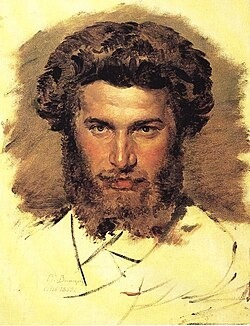

Arkhip Kuindzhi
RU
85
Artworks
1841 - 1910
Lifespan
Artist Biography
Arkhip Ivanovich Kuindzhi (1841–1910) was a celebrated Russian landscape painter of Greek descent, renowned for his masterful depiction of light and his innovative artistic techniques. Born in Mariupol, then part of the Russian Empire (now Ukraine), into a poor family of a Pontic Greek shoemaker, Kuindzhi was orphaned at the age of six. This early hardship forced him into various jobs, from working at a church construction site to grazing animals. His rudimentary education came from a Greek family friend and a local school. A nascent passion for art led him, around 1855, to Feodosia to seek tutelage under the famed marine painter Ivan Aivazovsky. However, his time there was largely spent mixing paints, and he primarily learned from Adolf Fessler, Aivazovsky's student. Despite this, Aivazovsky's dramatic use of light and form would leave a lasting impression on the young artist.
After working as a retoucher in a photography studio in Taganrog from 1860 to 1865, Kuindzhi moved to Saint Petersburg. He pursued his artistic studies largely independently, eventually enrolling as a non-matriculated student at the Imperial Academy of Arts in 1868, becoming a full member in 1893. During this period, Kuindzhi became associated with the Peredvizhniki (The Wanderers), a group of realist artists who rebelled against academic constraints to create art that was both Russian in spirit and accessible to the common people. His early works, such as "On the Valaam Island" (1872), which was the first of his paintings acquired by Pavel Tretyakov for his gallery, and "The Snow" (1873), which won a bronze medal in London, reflected the Peredvizhniki's social concerns and realist approach, though his unique style was already beginning to emerge.
The mid-1870s marked a significant evolution in Kuindzhi's art as he began to focus intensely on capturing the most expressive and dramatic aspects of natural light. He employed innovative compositional techniques, such as high horizons, to create breathtaking panoramic views. His use of intense, often contrasting colors and his experimentation with pigments – possibly influenced by his friendship with the renowned chemist Dmitri Mendeleev – allowed him to achieve an almost magical illusion of illumination. Masterpieces from this period, including "Evening in Ukraine" (1876), "A Birch Grove" (1879), "After a Thunderstorm" (1879), and the iconic "Moonlit Night on the Dnieper" (1880), captivated audiences. These works showcased his ability to convey the sublime beauty of nature, particularly the ephemeral qualities of moonlight, sunlight, and twilight, with an unparalleled intensity.
Kuindzhi's solo exhibitions between 1880 and 1882 were groundbreaking events. He famously exhibited "Moonlit Night on the Dnieper" in a darkened room, with a single focused light source illuminating the canvas, enhancing its mystical glow and creating a sensational public response. This innovative presentation, coupled with the painting's inherent brilliance, drew unprecedented crowds. However, at the height of his fame in 1882, Kuindzhi mysteriously withdrew from public exhibitions, entering a "period of silence" that lasted nearly two decades. Despite this reclusiveness, he continued to paint privately and dedicate himself to teaching. He became a professor at the St. Petersburg Academy of Arts in 1892 and headed its landscape workshop from 1894, influencing a generation of artists including Nicholas Roerich and Arkady Rylov, before being dismissed in 1897 for supporting student protests.
In his later years, Kuindzhi continued his artistic experiments, with works like "Ai-Petri. Crimea" (1890s) and "Red Sunset on the Dnieper" (1905-1908) demonstrating his enduring fascination with dramatic light and color. Though he lived modestly with his wife, Vera Leontievna Kechedzhi-Shapovalova, Kuindzhi had become a wealthy man, partly through astute property dealings. He was a generous philanthropist, supporting needy students and advocating for artistic reforms. In 1909, he initiated the creation of the Society of Artists (later named the Kuindzhi Society), to which he bequeathed his entire fortune, his remaining artworks, and his Crimean estate, ensuring a lasting legacy of support for Russian art. Kuindzhi passed away in 1910 in Saint Petersburg, leaving behind a body of work that continues to be celebrated for its unique vision, technical innovation, and profound emotional impact. His art, reflecting his diverse heritage (Greek, Tatar, Ukrainian, and Russian), remains a significant part of world cultural heritage, a testament to the power of light and landscape.